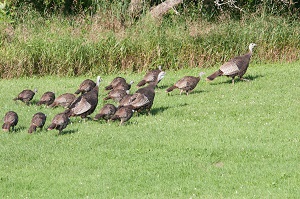
The Vermont Fish and Wildlife Department is seeking the public’s help with monitoring wild turkeys.
Since 2007, the department has run an annual online survey for reporting turkey broods in August. Beginning in 2021, the survey was expanded to include the month of July. The use of “citizen scientists” in this way facilitates the department’s ability to collect important turkey population and productivity data from all corners of the state.
If you see a flock of turkeys in Vermont during July and August, the department asks you to go to the turkey brood survey on its website (www.vtfishandwildlife.com) and report your observations including where and when you observed the turkeys along with the number of adult and young turkeys, or poults you observed. The value of the data collected from this survey is wholly dependent on the number of people who participate.
“Information gathered from this survey helps us monitor long-term trends in the productivity of Vermont’s wild turkey population,” said Vermont Fish and Wildlife’s turkey biologist Chris Bernier. “It also helps us assess the impacts of spring weather on the survival of poults and adult turkeys which is an important consideration in the management of turkeys.”
“We monitor and manage wild turkey numbers annually in order to maintain a healthy, abundant and sustainable population of these iconic and ecologically significant birds throughout the state,” added Bernier. “Beyond providing Vermonters with a local source of protein and an enduring connection to their environment, turkey hunting is the principal mechanism for managing Vermont’s turkey population. Please help us scientifically manage the turkey population by reporting your Vermont turkey sightings during July and August.”
“We moved from an August-only survey to a July and August survey last year in order to bring our survey protocol into compliance with the regional protocol. One of the biggest benefits of this survey is being able to compare productivity trends across turkey range and the only way we can do this effectively is if all the Northeast states collect these data in the same way.”
